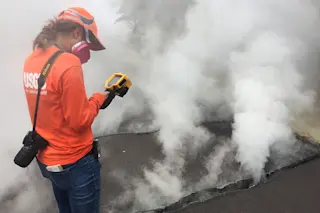A USGS scientist measures the temperature of gases emitted from a fissure at Leilani Estates on May 9, 2018. USGS/HVO. The eruptions at Kilauea took a bit of a break over the last day -- at least at the surface. The fissures that opened in Leilani Estates (see above) haven't erupted much new lava, but the are still emitting copious amounts of volcanic gases like sulfur dioxide. So, right now, that is the biggest hazard for people on the east side of the big island: the threat of volcanic fog, or vog. The mixture of water and sulfur dioxide makes acid, which can then irritate eyes, nose, mouth and lungs (at best) and cause extreme respiratory distress and death (at worst). However, as with most volcanoes, the real action to watch is happening underground. Earthquakes continues under the Puna area where the fissures opened and there is some indication that ...
Kilauea Calms Briefly While Merapi in Indonesia Erupts Anew
The Kilauea volcanic eruption raises concerns with sulfur dioxide emissions and steam-driven explosions threatening Hawaii Volcanoes National Park.
More on Discover
Stay Curious
SubscribeTo The Magazine
Save up to 40% off the cover price when you subscribe to Discover magazine.
Subscribe













